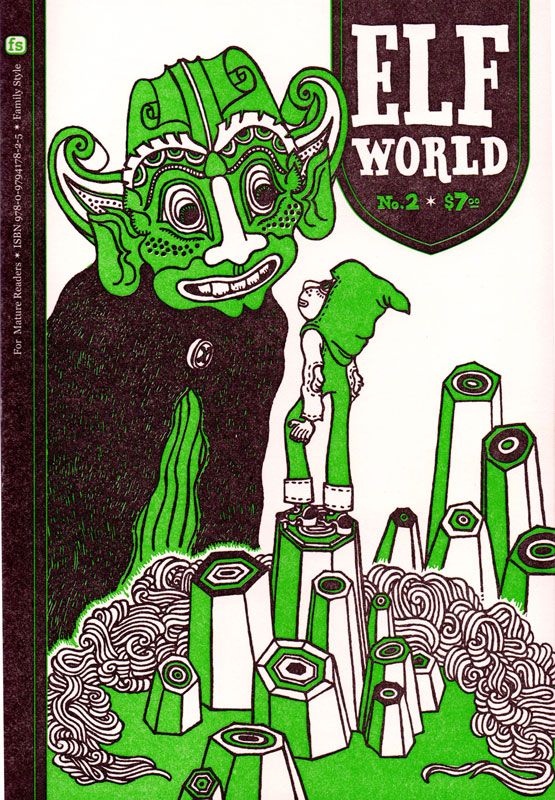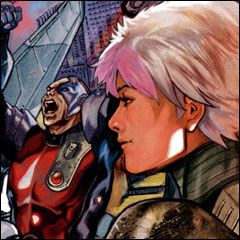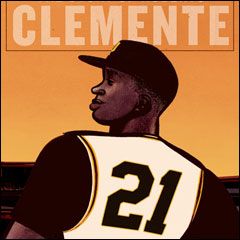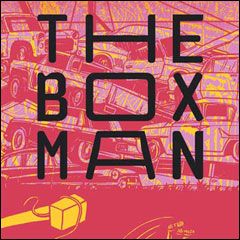Hello and welcome to What Are You Reading? Today our special guest is Fantagraphics' Marketing Director Mike Baehr, who runs their indispensable company blog, Flog!, among other duties.
To see what Mike and the Robot 6 crew have been reading, click below.
*****
Tim O'Shea
Thunderbolts 162: Holy crap, Jeff Parker. How long have you been holding onto to the Giant-Sized Man-Thing card? Best Thunderbolts moment in a long time. In the increased publishing schedule dynamic, I do not think I will ever see a more jarring shift than when the story shifts from Valentine De Landro to Matthew Southworth.
Supergirl 67: Really ashamed that we do not get to read more of Kelly Sue DeConnick's Supergirl. But good lord, Chriscross' penchant for drawing ugly-as-hell bone structured faces almost killed any enjoyment I had in this story. It astounds me how such an accomplished and talented artist utterly fails to make any effort to consistently draw character's faces the same way. Extra points to DeConnick for ending the issue on a note that would have been a mild series gamechanger (a secret revealed) had the series continued beyond this point.
Venom 6: OK this whole Spider Island event. Am I the only person that sings Spider Island to the melody of that 1970s rock classic by Jay Ferguson, Thunder Island, whenever I see the phrase? I have one question was it writer Rick Remender or artist Tom Fowler who decided to have the Venom symbiote bond with a dog? Visually a great bit. There's always a fun horror-vibe whenever the issues are drawn by Fowler.
Gladstone's School for World Conquerors 4: The issue opens with a great battle scene (with beautifully vibrant colors by Carlos Carrasco), leading to, of all things, a study group session? (This series is like 1960s X-Men comics, but on acid, which is a good thing for me [the comic, not the acid, that is]). But what makes this issue a must buy for me is writer Mark Andrew Smith and artist Armand Villavert's dead-on riff on Scott McCloud's storytelling approach in Understanding Comics (special thanks to my friend Dugan Trodglen for pointing this out to me). An aside, the issue is dedicated to Scott McCloud ("one of the greatest teachers in comics").
Power Girl 27: Matthew Sturges tells a 60-second story. With Power Girl's speed, of course, there's a lot to cram in that 60 seconds. But honestly, it must be hard to understand all that she says in that 60 seconds, because she says a lot. Matthew Sturges, another writer who writes females well. Curious to see where he'll end up in the new DCU.
Cloak & Dagger: Spider Island 1: This actually came out last week, but my pal Dugan convinced me to pick it up this week. Glad I did. Writer Nick Spencer and artist Emma Rios clearly are taking a swing at an ongoing series with this miniseries. So far, the Spider Island connection is fairly mo's second dular, they could have just as easily plugged in a Fear Itself moment and run the same story. I am not complaining, as the dual (Cloak & Dagger) narration that Spencer employs is really effective. Much of the first issue is a rehash of where the characters have been before, but the life recap actually served to draw me into the tale. I look forward to seeing what issue 3 brings. I'm really impressed with how much more confident and effective that Rios' art has gotten since the Strange miniseries (with Mark Waid) from a year or so back.
Hulk 39: So my good pal (and I must add, damn fine writer) Carla Hoffman does not feel the love for Red Hulk (as documented in this week's always must read Fifth Color) that I so clearly possess. This issue perfectly exemplifies why I find Parker and artist Gabriel Hardman's Hulk to be a great exploration of Thaddeus "Thunderbolt" Ross. Despite the fact that he cannot currently change back to his human form, Red Hulk is very much defined by the human that Ross is. No one else creates as cinematic-like and dynamic layouts as Hardman. The flashback to Ross' childhood in this issue is some of the most compelling storytelling I've read in months. I want a whole damn arc with Thaddeus and his childhood pals. Hoffman, please read this issue.
Daredevil 2: In this issue, writer Mark Waid subtextually reveals that he wants to marry Captain America's shield. But seriously, I think spending time as BOOM's big editorial honcho gave Waid a chance to sit back and look at the dynamics of the Marvel universe (something he obviously had mulled prior to BOOM admittedly) and is allowing that inform his approach to this book. Dating back to the days of Waid's second run on Captain America, I have clearly appreciated his basic concept of seeing Marvel heroes and their weapons as props to be explored (remember when Cap lost his shield for that run?). As issue 2 opens, Daredevil quickly gains control of Cap's shield and Cap snags DD's billy club. To see the way the two tacticians wield the weapons is a storytelling treat, particularly given artist Paolo Rivera's complete commitment to the scenes. DD uses Cap's shield as an urban boogieboard, for Pete's sake. When Waid has DD say: "That thing (the shield) is beautifully balanced, by the way. It's like touching a Stradivarious. High point of my evening." I giggled in delight like my 10 year old self. In two issues this creative team has given me the DD I have not seen since the days of Karl Kesel's short run (#353-357, 359-364 [thanks very much manwithoutfear.com])--a fun to read comic. Added bonus, editor Steve Wacker runs a letter column with letters from the 1960s issues.
Tom Bondurant
Finally, the magic of eBay has delivered unto me Jack Kirby's Monolith-sized adaptation of 2001: A Space Odyssey, and the combination of Kubrick, Clarke, and the King was pretty engaging. I had read some of the regular-series 2001, and of course I have seen the movie (and read the books) many times over, but this felt much more like '70s Cosmic Kirby -- much more in the spirit of The Eternals, say -- than a straightforward adaptation. In fact, Kirby's dynamism is diametrically opposite Kubrick's cool, meditative style. Thus, the Dawn Of Man scenes are beefed up with insight into Moon-Watcher's thoughts and feelings. Dr. Floyd and his colleagues get a little more attention. The Star-Gate sequence is translated into a series of breathtaking double-page spreads. Kirby does a pretty faithful version of the famous bone-to-satellite jump-cut, but he modifies the look of the Pan Am clipper to more closely resemble the (then-experimental) Space Shuttle orbiter. Ironically, the characters who suffer the most are Bowman and Poole, both of whom come across fairly generic. In a way, this was in keeping with Kirby's plans for the regular series, in which a procession of ordinary humans were transformed by the power of the Monolith. Still, Kirby's 2001 and Clarke/Kubrick's 2001 share the same basic cautions about humanity's development, and in the end that's what matters.
I've also been catching up on John Ostrander and Jan Duursema's Star Wars Legacy series, having bought a couple of paperbacks from the emptying shelves at the local Border's. So far I'm through volume 3, and I like it pretty well. Cade Skywalker does have a somewhat predictable "you can't make me" attitude, although I guess that's one way of following in his ancestors' whiny ways. Also, I can't quite get past his relentlessly-coiffed appearance, which threatens to be more monsters-of-rock than a Star Wars character should be. Overall, though, it's a good next-generation take on the Galaxy Far, Far Away, and it stands alone well enough that the occasional ties to the movies are just a bonus.
There's something of an unfinished aesthetic to the first few years of "New Look" Batman stories (reprinted in color in Dynamic Duo Archives Vols. 1 and 2, and in the black-and-white Showcase Presents Batman Vol. 1). Mostly this is due to the relative lack of Carmine Infantino pencils. The Bob Kane studio (including Sheldon Moldoff) still drew the bulk of the stories, with Infantino only on covers and pencilling every other issue of Detective. (Inker Joe Giella gave everything a consistent feel.)
Among the memorable stories so far are November 1964's "Zero Hour For Earth!" (Batman #167) and "Hunters of the Elephants' Graveyard!" (Detective #333), and "Partners In Plunder!" from February 1965's Batman #169. "Zero Hour" was written by Bill Finger, with pencils credited to Bob Kane, and features Batman and Robin on a globetrotting mission to stop the nefarious organization known as Hydra. (Yes, this predated Marvel's Hydra by a couple of years, but the Bat-office might already have taken a shot at Marvel a few months earlier, when a megalomaniacal mutant threatened the world in "The Man Who Quit The Human Race!") Anyway, "Zero Hour" is the kind of story that the hairy-chested love god of the '70s would have found familiar; although Kane/Moldoff's Batman was hardly hairy-chested. "Hunters" was written by Gardner Fox and pencilled by Infantino, and it is probably the last word on Batman vs. a herd of rampaging pachyderms. Specifically, it's very effective at setting up the elephants as noble creatures, and then turning them into a giant mass of stampeding trouble. Most clever of this bunch is "Partners In Plunder," written by Ed "France" Herron and pencilled by Moldoff, which finds the Penguin deciding simply to create random chaos with trick umbrellas, and then basing his future capers on Batman's subsequent speculation. It's a neat idea which plays perfectly off of the "Batman is never fooled" trope, and in fact it ends with the Penguin in prison and Batman never realizing he's been duped.
Finally, I enjoyed the Batman and Wonder Woman '90s Retro-Active specials, mostly because the creative teams of Alan Grant and Norm Breyfogle and William Messner-Loebs & Lee Moder produced stories which didn't miss any beats from their earlier work. The Wonder Woman story especially made me wonder why DC wouldn't turn to Messner-Loebs and Moder more often. Sure, it was a quiet, character-oriented piece about Wonder Woman bonding with a group of mallrat girls, but the reprint was the start of Messner-Loebs' outer-space saga, and that was plenty action-oriented. If anything lasting comes out of the Retro-Active experiment, I really do hope it involves more work for Messner-Loebs, who clearly still has the chops to handle these characters.
Brigid Alverson
I have started reading Wilifred Santiago's "21": The Story of Roberto Clemente several times, but I always wandered off: This time I pulled it off my stack and read it most of the way through. I love Santiago's style and his depiction of Clemente's childhood in Puerto Rico, but the story is hard to follow for a number of reasons. One is the huge cast of characters, who simply appear and start having conversations as if they had known each other forever, with no background on who they are. The story also moves around in
time in a confusing way, especially in the beginning, and seems to skip important events‹how did Clemente go from being voted 8th in the Most Valuable Player poll to having Roberto Clemente Day at Three Rivers Stadium ten years later? Still, Santiago really captures the feeling of listening to a ball game on a hot summer day, and his story is rich and complex, if flawed. I'm glad I read it.
Also on the stack this week was an advance copy of The Last Dragon, a gorgeous fantasy graphic novel written by YA author Jane Yolen (Foiled) and illustrated by Rebecca Guay, who is probably best known as one of the illustrators of the card game Magic: The Gathering. Guay's style is a throwback to the Golden Age of children's books, reminiscent of Maxfield Parrish and Arthur Rackham in its combination of pseudo-classical styling and luminous color. I usually find books like this boring, but Yolen pairs up a smart young woman with a blowhard Fabio look-alike to accomplish the central task of the story, killing a dragon that has been terrorizing a small village. It's a fairy-tale type story that manages to feel fresh despite its traditional setting and tropes. It's due out in early September, and it's definitely something to watch for.
Finally, I picked up Doctor Who Volume II: The Ripper on a whim and I really enjoyed it. The book collects four of IDW's Doctor Who comics featuring the Eleventh Doctor. In the first story, Rory uses a cell phone in the Tardis and as a result all his (and Amy's) spam and social-networking contacts come to life. It's very well done, and some of the anthropomorphized spam made me laugh out loud. The second story comprises three arcs of the comic and it's a Doctor Who take on Jack the Ripper. You really don't have to be familiar with the television program to enjoy these stories‹I have been away from Doctor Who since the 1970s, and I still could follow them. In fact, it
worked the other way for me: I started watching the show with my daughter and I actually knew who the characters are. Incidentally, all the stories are available via IDW's digital app, for less than the cost of the trade paperback, and if you have an iPad, the two bucks you spend on that first story will be the best money you spend all week.
Mike Baehr
My to-read pile contains about 12 feet of graphic novels and comics right now, with about half of that being Fantagraphics stuff -- we're literally putting out books faster than I can read them. I'll try not to be too much of a shill for my employers, but what kind of Marketing Director would I be if I didn't love what we put out?
I just finished plowing through my stash of minicomics from the Stumptown Comics Fest. Elf World from Family Style is a fun anthology series of fantasy stories by independent and small-press artists, and the first 2 issues of the 2nd volume have the nicest production values I've seen in minicomics, with gorgeous letterpress covers illustrated by Sammy Harkham and Daria Tessler. Salad Days by Minty Lewis is another standout -- no one depicts awkward conversations and the minor humiliations of life quite like her, and all with a cast of talking fruit, which gives it a sense of absurdity but somehow heightens my empathy for the characters at the same time. Too Dark to See by Julia Gfrörer is chilling for the way it depicts how the damage that we do to ourselves and each other is far greater than any supernatural threat. And after one issue I've completely fallen in wuv with Ed Luce's adorable and hilarious Wuvable Oaf (soon to be seen in Fantagraphics' forthcoming queer comics anthology No Straight Lines), which stars a big hairy metal-and-Morrissey-loving gay dude and his friends, plus a bunch of kitties. I definitely need to pick up the rest of that series.
At Comic-Con last month I finally picked up a copy of The Box Man by Imiri Sakabashira, published by our "Distinguished Qompetition." It's like a mashup of a Jim Woodring Frank story, Hans Rickheit's The Squirrel Machine, and a Mat Brinkman comic (with maybe a dash of Brian Ralph) as the protagonist and his animal companion journey through an incredibly detailed detritus-strewn urban underbelly on a mysterious mission, encountering various forms of peril and bizarre debauchery along the way. It's part maximum weirdness, part straight-up thrilling action, all depicted with breathtaking skill. I'm surprised I didn't hear more about this book when it first came out.
My current favorite ongoing webcomic is Steven Weissman's Barack Hussein Obama, which I have the privilege of posting on the Fantagraphics website every week. Steven's work has undergone a really interesting transformation over the last few years, and he really cuts loose with this sketchbook strip, mashing up old-fashioned gag humor, Lovecraftian horror, bizarre nonsequiturs and absurd interpersonal drama. It's a combination that could only come from Steven and it makes for a dizzying and thrilling reading experience. I also enjoy seeing the remastered reruns each week at What Things Do (the best webcomics site out there bar none), and I'm excited that we'll be putting out a book collection of the strip next year.
There's a ton of recent and upcoming Fantagraphics books that I'm chomping at the bit to read (Prison Pit 3, Michael Kupperman's Mark Twain book, Gahan Wilson's Nuts, Willie & Joe: Back Home, The Man Who Grew His Beard) but one that leaped to the top of the pile was the new 4th issue of the Hernandez Brothers' Love and Rockets: New Stories. I actually first read this as a printout a few weeks ago but it's been hard to stop picking it back up now that I have a bound copy. Pretty much everyone who's read it has said that it moved them to tears, and I'm no exception. Jaime's stories in the issue are some of the most emotionally powerful fiction I've ever read -- as devastating as "Browntown" was in the last issue, Jaime takes it to the next level here. Brace yourself because Jaime takes you on a rollercoaster ride. So many "oh my god" and "holy crap" moments. And Gilbert is absolutely at the top of his game here too. The metafictional world he's been building over the last few years is super-fascinating to me, and the new directions he pushes himself within that world are exhilarating.
To continue in shill mode for just a bit longer, another thing I just read is the Fantagraphics Spring/Summer 2012 distributors catalog, with all of our books slated for April-August of next year, which we just sent off to the printer. People tell me all the time that we put out too many good books, all I can do is agree and say HOO-EE, that's not about to change anytime soon!






